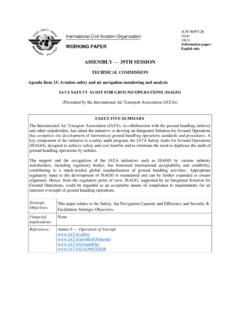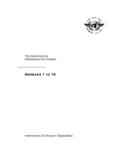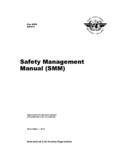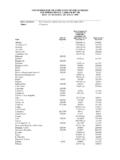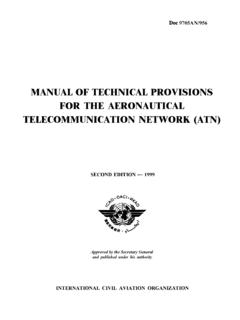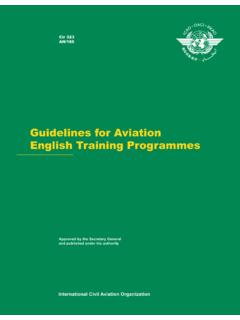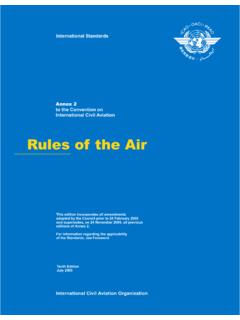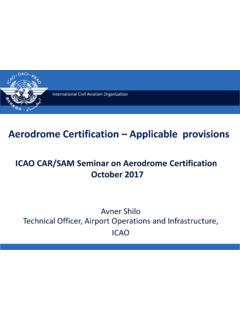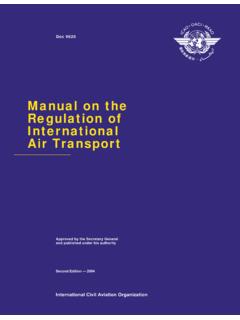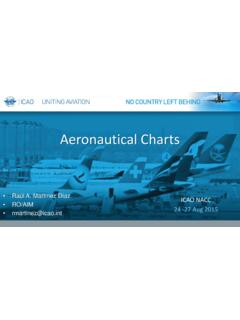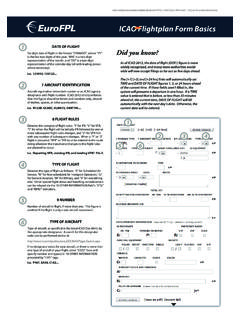Transcription of World Geodetic System 1984 (WGS-84) Manual - ICAO
1 international civil aviation OrganizationApproved by the Secretary Generaland published under his authorityWorld GeodeticSystem 1984(WGS-84) ManualSecond Edition 2002 Doc 9674AN/946 international civil aviation OrganizationApproved by the Secretary Generaland published under his authorityWorld GeodeticSystem 1984(WGS-84) ManualSecond Edition 2002 Doc 9674AN/946 AMENDMENTSThe issue of amendments is announced regularly in the icao Journal and in themonthly Supplement to the Catalogue of icao Publications and Audio-visualTraining Aids, which holders of this publication should consult.
2 The space belowis provided to keep a record of such OF AMENDMENTS AND by(ii)(iii)FOREWORDThe Council of the international civil aviation Organiza-tion ( icao ), at the thirteenth meeting of its 126th Sessionon 3 March 1989, approved Recommendation of thefourth meeting of the Special Committee on Future AirNavigation Systems (FANS/4) concerning the adoption ofthe World Geodetic System 1984 (WGS-84) as thestandard Geodetic reference System for future navigationwith respect to international civil aviation . FANS/4 Recommendation reads: Recommendation.
3 Adoption of WGS-84 That icao adopts, as a standard, the Geodetic referencesystem WGS-84 and develops appropriate icao material, particularly in respect of Annexes 4 and 15, inorder to ensure a rapid and comprehensive implemen-tation of the WGS-84 Geodetic reference System . The Council, at the ninth meeting of its 141st Session on28 February 1994, adopted Amendment 28 to Annex 15,introducing the provisions concerning the promulgation ofWGS-84-related geographical coordinates. Consequentialamendments to Annexes 4, 11 and 14, Volumes I and II,were adopted by the Council on 1 March 1995,18 March 1994 and 13 March 1995, respectively.
4 On20 March 1997 the Council, at the seventeenth meeting ofits 150th Session, adopted Amendment 29 to Annex 15introducing publication of the vertical component of theWGS-84 Geodetic reference System . Consequential amend-ments to Annexes 4 and 14, Volumes I and II, were adoptedby the Council on 20 March 1998 and 21 March 1997,respectively. The Standards and Recommended Practices(SARPs) in Annexes 11 and 14, Volumes I and II, governthe determination (accuracy of the field work) andreporting of geographic coordinates in terms of the WGS-84 Geodetic reference System .
5 Annexes 4 and 15 SARP sgovern the publication in textual or graphical form ofgeographic coordinates (resolution) and verticalcomponents. States aeronautical information servicedepartments will publish in their Aeronautical InformationPublications (AIPs), on charts and store in electronicdatabases where applicable, geographic coordinate andvertical component values based on WGS-84 which aresupplied by the other State aeronautical services, such asthe air traffic service and the aerodrome/heliport purpose of this Manual is to furnish guidance on theprovision of geographic coordinates and verticalcomponent values referenced to the WGS-84 datum inorder to assist States in the uniform implementation of theSARPs on WGS-84 as contained in:Annex 4 Aeronautical Charts.
6 Annex 11 Air Traffic Services;Annex 14 Aerodromes,Vo l u m e I Aerodrome Design and Operations andVo l u m e I I Heliports;Annex 15 Aeronautical Information Manual has been prepared in consultation andcoordination with the European organization for the Safetyof Air Navigation (EUROCONTROL) and will beamended periodically. Users are invited to forward to icao suggestions for improvements or additions based on theirpractical experience when using the Manual . Errors ordiscrepancies noticed in the Manual should be brought tothe attention of:The Secretary GeneralInternational civil aviation Organization999 University StreetMontreal, Quebec, Canada H3C 5H7 (v)TABLE OF CONTENTSPagePageChapter 1.
7 Introduction .. of using differingcoordinate reference systemsin aviation .. of the problem.. implications .. to the problem..1-2 Figures for Chapter 1 ..1-4 Chapter 2. Accuracy, Resolution andIntegrity of Aeronautical Data .. and classification of positionaldata .. of raw aeronautical data .. requirements .. requirements .. requirements ..2-3 Tables for Chapter 2 ..2-4 Chapter 3. The Global WGS-84 CoordinateSystem .. of the WGS-84 coordinatesystem .. of the WGS-84 coordinatesystem .. of WGS-84 coordinates ..3-1 Figures for Chapter 3.
8 3-3 Chapter 4. A guide to obtain WGS-84coordinates .. 1: Coordinates in a localreference frame are available .. 2: Coordinates of the requiredaccuracy are not available .. 3: Digitized coordinates frommaps are available ..4-4 Figures for Chapter 4 ..4-6 Chapter guidance .. specifications .. requirements for aerodrome/heliport-related navigation elements .. survey reportrequirements .. requirements for navigation aids .. survey report requirements .. of software .. format for the delivery ofsurvey data..5-7 Attachment A to Chapter ..5-81. General.
9 5-82. Numbering System for survey markers ..5-8 Figures for Attachment A ..5-9 Attachment B to Chapter ofgeographical positions .. 5-12 Figures for Attachment B .. 5-13 Attachment C to Chapter reports .. 5-321. Geodetic connection .. 5-322. Aerodrome/heliport survey.. 5-323. En-route survey .. 5-32 Attachment D to Chapter ofthreshold coordinates .. 5-34 Chapter assurance .. definitions .. assurance (QA)..6-2 Figures for Chapter 6 ..6-5 Chapter .. reporting requirements .. reporting structure ..7-1(vi) World Geodetic System 1984 (WGS-84) , standard algorithms andworking practices.
10 7-2 Figures for Chapter 7 ..7-6 Appendix A. The Global PositioningSystem (GPS)..A-1 Figures for Appendix A ..A-6 Appendix of geodesy..B-1 Figures for Appendix B..B-7 Appendix C. The international TerrestrialReference System (ITRS) ..C-1 Appendix transformation formulae ..D-1 Figure for Appendix D ..D-5 Appendix and photogrammetricmethods ..E-1 Figures for Appendix E..E-4 Appendix projections ..F-1 Appendix G. Sample questionnaire ..G-1 Bibliography1-1 Chapter OF USING DIFFERINGCOORDINATE REFERENCESYSTEMS IN datum problems in air navigationwere first encountered in Europe in the early 1970s duringthe development of multi-radar tracking systems forEUROCONTROL s Maastricht Upper Airspace Centre(UAC), where plot data from radars located in Belgium,Germany and the Netherlands were processed to form acomposite track display for air traffic controllers.
